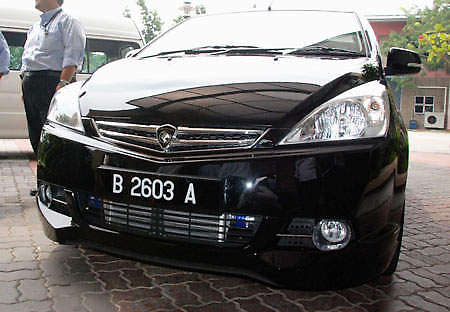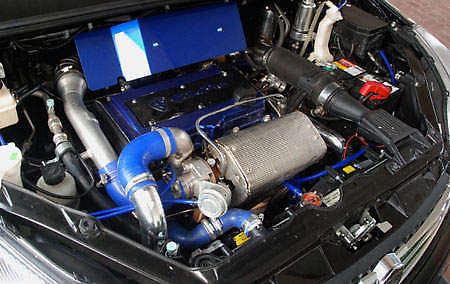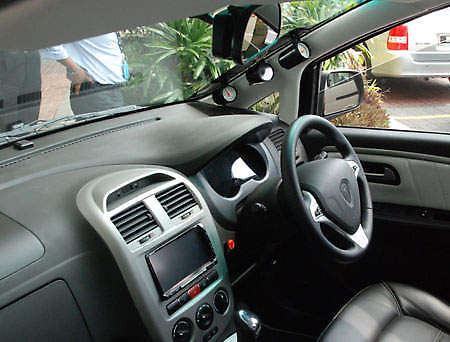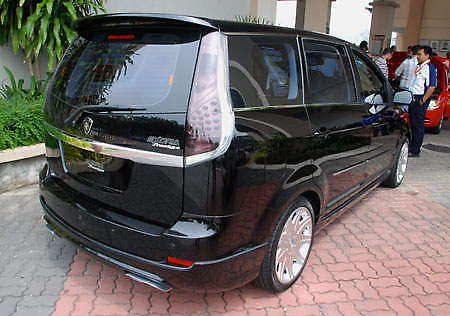Proton Exora

After a long long wait, Malaysians finally have a decently sized MPV at a decent price to choose from. The
new Proton Exora is here and two variants will be available at launch time – a 1.6 liter automatic high-line and a 1.6 liter automatic medium-line, priced at
RM75,998.00 and
RM69,998.00 respectively OTR with insurance. Head on after the jump for the full scoop on the Exora.
 Dimensions, Power, Weight – Technical Data
Dimensions, Power, Weight – Technical Data
Firstly I think I have to address the actual dimensions of the car, because when you buy an MPV what you are looking for is essentially a big box to fit your family in. There has been some revision to the data that Proton provided us during the prototype test drive (particularly the weight, which is now heavier – 1422kg for M-Line and 1442kg for H-Line). Here are the final specs of the Exora in comparison to its competitors.
| Exora | Livina 1.6 | Avanza 1.5 | Rondo | Innova |
| Kerb Weight | 1,422kg | 1,245kg | 1,120kg | 1,563kg | 1,575kg |
| Length | 4,592mm | 4,420mm | 4,150mm | 4,545mm | 4,580mm |
| Width | 1,809mm | 1,690mm | 1,630mm | 1,800mm | 1,770mm |
| Height | 1,691mm | 1,590mm | 1,695mm | 1,650mm | 1,755mm |
| Wheelbase | 2,730mm | 2,600mm | 2,655mm | 2,700mm | 2,750mm |
| Track (F) | 1,542mm | 1,470mm | 1,415mm | 1,573mm | 1,510mm |
| Track (R) | 1,530mm | 1,475mm | 1,425mm | 1,569mm | 1,510mm |
| Fuel Tank | 55L | 52L | 45L | 55L | 55L |
| Power (hp) | 125hp | 104hp | 108hp | 142hp | 134hp |
| Torque (Nm) | 150Nm | 150Nm | 141Nm | 189Nm | 182Nm |
| kg/Nm | 9.48 | 8.3 | 7.94 | 8.27 | 8.65 |
The power figures above are quoted in horsepower, which has been converted from most of the “PS” measurements that Japanese companies use. As you can see the weight is now heavier, which would throw off all our previous calculations on the Exora’s power to weight ratio.
The Exora’s 125 horsepower has to pull 1422kg of weight now which means 11.376kg per horsepower, which is actually one of the better performing numbers among its competitors unfortunately the amount of weight that each Newton Meter has to pull is one of the worst. It’s the amount of torque and the torque curve that matters when it comes to pulling a lot of weight.
 Click for enlarged image
Design
Click for enlarged image
Design

Design is subjective but I personally feel the Proton Exora is quite pleasant to the eyes. I don’t quite like the chrome strip at the rear but it doesn’t hamper the vehicle’s functions as an MPV. The brake lights are LEDs but the signal lamps use conventional bulbs. The radio uses a bee-sting antenna mounted at the front.
The M-Line model lacks foglamps, the chrome on the rear strip and the pieces of trim on the front grille, and it also lacks the black-out stickers on the B-pillar and C-pillar. I feel the Exora looks better with the blackout pillars (though when I did my own little survey one colleague thought the opposite was better and another was neutral about it) but it should be easy for you to place your own stickers.
Both the M-Line and H-Line models use the same 15 inch wheels. These are wrapped with either Goodyear Assurance or Silverstone Kruizer tyres in 195/65R15 size, apparently they are the same for both M-Line or H-Line and which tyres you get depends on luck as different batches will be fitted with either one.
New Proton Exora Platform
 Click for enlarged image
Click for enlarged image
The first sketch for the Exora has been in existence for a long time, even in the 90s. The styling was finally fixed sometime in August/September 2007. After that, it took another 18 months of development after the styling fix to reach mass production, which had been ready since March 2009. Production trial 1 had actually started end last year, while production trial 2 lasted the second half of February. Production started sometime mid-March until now.
The new Proton Exora sits on a platform that was developed by Proton engineers with the help of their engineering consultancy partner LG CNS. LG CNS also assisted Proton with the development of the Savvy platform, which was later revised to become the Saga platform.
It has a MacPherson strut layout at the front and a torsion beam at the rear, with the spare tyre stored underneath the vehicle body. It’s interesting to note that this chassis also has a multi-link variant ready. You know how the Wish had both a multi-link setup and a torsion beam version offered? Well, the Exora has the potential for that too. It will be easy to add a multi-link setup at the rear to make way for all-wheel drive in case it is needed in Eastern European countries or something.

In terms of ability to fit a wide range of engines, the Proton Exora’s platform was designed to take anything from a 1.3 liter inline-4 to a 60 degree V6 in its engine bay. An engine as big as a 2.5 liter V6 would be no problem for the chassis to fit, but for now the only engine that’s going to be fitted to it in production is the 1.6 liter Campro CPS.
The Campro CPS engine produces 125 horsepower (127 PS) at 6,500rpm and 150Nm of torque at 4,500rpm. The gear ratios are the same as the Waja CPS but the final drive has been modified from 4.406 in the
auto and 4.312 in the manual to 4.625 for both the auto and manual. In the auto model, the Exora cruises at 2,400rpm for 80km/h and 3,000rpm for 110km/h (approximation from looking at the meter panel). It has been rated to consume 9.2 liters per 100km on the combined cycle and 7.2 liters at 90km/h constant. The following are the Exora’s gear ratios:
| A/T | M/T |
| 1st | 2.842 | 3.583 |
| 2nd | 1.529 | 1.947 |
| 3rd | 1.000 | 1.379 |
| 4th | 0.712 | 1.03 |
| 5th |
| 0.767 |
| Reverse | A/T | 3.363 |
| Final Drive | 4.625 | 4.625 |
Because this is their first ever MPV and does not carry over any existing large vehicle platform, Proton has had the luck of being able to develop a monocoque MPV in this segment without having the restrictions of modifying an existing car to do it.

Proton decided that the development process had to start from the inside out. This is why the MPV manages to be spacious without growing into a large sized behemoth. The seat, hip points, interior height and etc were all determined first, only then are the other parts of the chassis and body designed around it, including the exterior design of the car. The designers had to work within these restrictions and I must commend them on doing a great job in making the MPV look pleasant to the eyes.
Based on CAE data, the Proton Exora has a torsion rigidity of 16,683 Nm/degree based on lab tests, and a bending rigidity of 18,823 Nm/mm based on lab tests. Proton claims the Exora was designed to achieve a 4-star rating in Euro NCAP crash tests and it has passed an Euro NCAP equivalent test at a private testing facility in Spain. Actual Euro NCAP testing has not been done yet but as the test specs were the same the Exora should be able to gain a 4 star result in real Euro NCAP testing as well. But for now there is no official test yet so you won’t find the Exora on the Euro NCAP website.
For the first time in a Proton, the Proton Exora uses front impact sensors as part of the airbag activation system. Previously the airbags are only activated via data from an accelerometer
M-Line and H-Line Differences

The basic features of the car itself is the same between the M-Line and H-Line. They are the same even down to the
safety features (dual airbags and ABS), alloy wheel design, brake types (front disc rear drum), seat configuration ability, electric wing mirrors, interior trim and even the tires. Proton has only kept the creature comforts and minor styling differences for the H-Line.
The Proton Exora H-Line adds
cruise control, the LCD screen with DVD player, leather seats, and slightly different trim on the outside – chrome for the grille and rear, as well as blacked out B and C pillars using some convincing black stickers. It’s good to know that the Bluetooth hands-free and audio streaming functionality of the 2-DIN head unit has been retained in the M-Line. If you notice, the leather seats in the H-Line version have a combination material – there is a suede-like material at the sides, which according to Proton was intentionally left there so that the leather would be allowed to expand and contract in a certain way under the hot Malaysian climate and thus reduce the chances of them cracking.

There are still no ISOFIX points and there is only a lap belt for the middle seat in the second row instead of a full 3-point seatbelt. The seat and seatbelt anchorage points are said to be 30% better than regulation minimum requirements, and the steering wheel impact energy absorption is 35% better than regulation requirements.
Another feature of the H-Line is a touch screen portable GPS device which according to them uses an Atmel chipset. This is the same one as offered in the Persona SE. Locking speed was pretty fast. You can download new maps from the internet or at Proton Edar, and updates are free, but I didn’t manage to find out how many updates have there been so far and how frequent the updates are. I would have much preferred a Garmin-based solution.
The Exora’s Interior

The interior quality was typically Proton. There were some uneven gaps between the plastic parts of the dash but hopefully these will be ironed out as the assembly plant gets better at assembling the new model, same goes for the parts suppliers. The gap between the headlining and the front windscreen was quite alarming though, and apparently this was because of the need to wire the DVD player.
The plastics are not soft touch but the designers have picked textures in order to avoid that bare cheap plastic look. The textures were picked based on observations that the designers made while visiting the past few international motorshows. A total of 3 different types of plastic texture are used throughout the car. The upper dash and lower sections (glove box and below) of the dash have a different texture (Organic pattern) than the middle dash are which uses a pattern Proton calls “Orga-Geo”.

As previously mentioned the air conditioning was superb, thanks to the use of two blowers, one for the front and the other for the rear rows. There are air conditioning vents for all 3 rows, with the vents for the 2nd and 3rd row located above the windows. All three rows are comfortable, and a person of 182cm tall like me can fit into the third row nicely with my knee only barely touching the second row. Of course the second row has to be angled slightly more upright than usual for that to happen. Another point to consider is the third row is quite wide, two big sized guys can actually fit without their shoulders touching each other.
The second row and third row have backseat angle adjustment ability, so while you cannot slide them back and forth to vary space between the rows, if a compromise must be done it can be via the backrest angle. The second row will be able to sit more upright for the back row to have more legroom. The third row also varies in angle to create more luggage space in the rear. Speaking of luggage space, here is a video that Proton produced to train its salesmen on the luggage space of the Exora. Bear in mind what you see is with the third row angled rather straight, not the maximum lean angle.
M-Line and H-Line Differences

The basic features of the car itself is the same between the M-Line and H-Line. They are the same even down to the
safety features (dual airbags and ABS), alloy wheel design, brake types (front disc rear drum), seat configuration ability, electric wing mirrors, interior trim and even the tyres. Proton has only kept the creature comforts and minor styling differences for the H-Line.
The Proton Exora H-Line adds
cruise control, the LCD screen with DVD player, leather seats, and slightly different trim on the outside – chrome for the grille and rear, as well as blacked out B and C pillars using some convincing black stickers. It’s good to know that the Bluetooth hands-free and audio streaming functionality of the 2-DIN head unit has been retained in the M-Line. If you notice, the leather seats in the H-Line version have a combination material – there is a suede-like material at the sides, which according to Proton was intentionally left there so that the leather would be allowed to expand and contract in a certain way under the hot Malaysian climate and thus reduce the chances of them cracking.

There are still no ISOFIX points and there is only a lap belt for the middle seat in the second row instead of a full 3-point seatbelt. The seat and seatbelt anchorage points are said to be 30% better than regulation minimum requirements, and the steering wheel impact energy absorption is 35% better than regulation requirements.
Another feature of the H-Line is a touch screen portable GPS device which according to them uses an Atmel chipset. This is the same one as offered in the Persona SE. Locking speed was pretty fast. You can download new maps from the internet or at Proton Edar, and updates are free, but I didn’t manage to find out how many updates have there been so far and how frequent the updates are. I would have much preferred a Garmin-based solution.
The Exora’s Interior

The interior quality was typically Proton. There were some uneven gaps between the plastic parts of the dash but hopefully these will be ironed out as the assembly plant gets better at assembling the new model, same goes for the parts suppliers. The gap between the headlining and the front windscreen was quite alarming though, and apparently this was because of the need to wire the DVD player.
The plastics are not soft touch but the designers have picked textures in order to avoid that bare cheap plastic look. The textures were picked based on observations that the designers made while visiting the past few international motorshows. A total of 3 different types of plastic texture are used throughout the car. The upper dash and lower sections (glove box and below) of the dash have a different texture (Organic pattern) than the middle dash are which uses a pattern Proton calls “Orga-Geo”.

As previously mentioned the air conditioning was superb, thanks to the use of two blowers, one for the front and the other for the rear rows. There are air conditioning vents for all 3 rows, with the vents for the 2nd and 3rd row located above the windows. All three rows are comfortable, and a person of 182cm tall like me can fit into the third row nicely with my knee only barely touching the second row. Of course the second row has to be angled slightly more upright than usual for that to happen. Another point to consider is the third row is quite wide, two big sized guys can actually fit without their shoulders touching each other.
The second row and third row have backseat angle adjustment ability, so while you cannot slide them back and forth to vary space between the rows, if a compromise must be done it can be via the backrest angle. The second row will be able to sit more upright for the back row to have more legroom. The third row also varies in angle to create more luggage space in the rear. Speaking of luggage space, here is a video that Proton produced to train its salesmen on the luggage space of the Exora. Bear in mind what you see is with the third row angled rather straight, not the maximum lean angle.
Proton Exora 1.6L A/T M-Line Metallic – RM69,998.00
Proton Exora 1.6L A/T M-Line Solid – RM69,548.00
Proton Exora 1.6L A/T H-Line Metallic – RM75,998.00
Proton Exora 1.6L A/T H-Line Solid – RM75,548.00































































































































